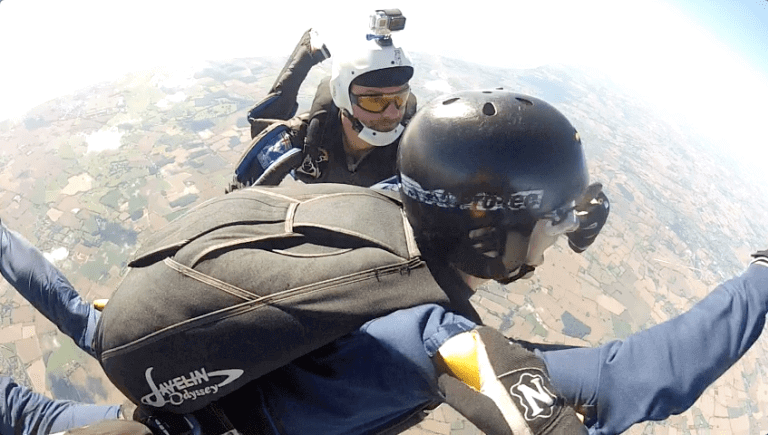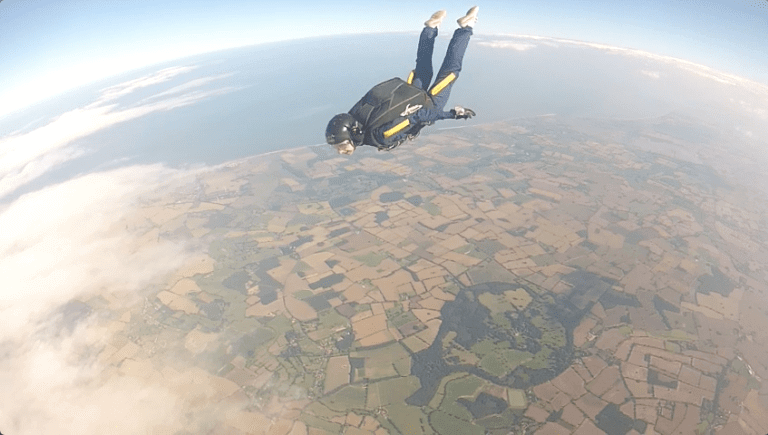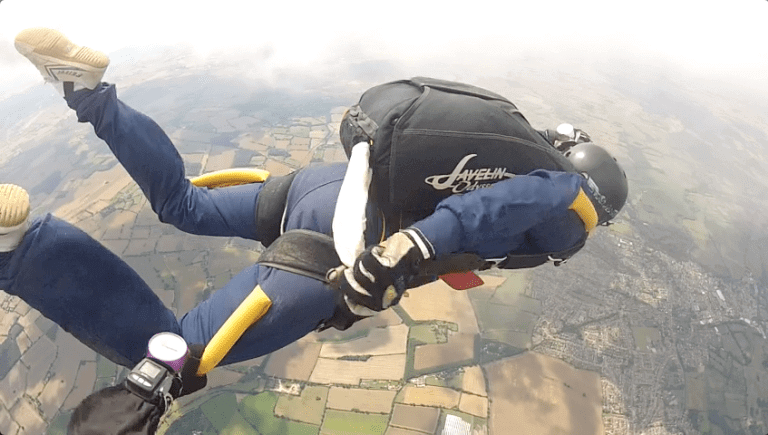What Skydiving Taught Me About Marketing
Lean out. Lean in. Roll out and arch. Freefall 13,000 feet above the ground. A mosaic of British farmland stretches beneath me and the North Sea sparkles on the horizon, but I notice nothing. Despite 6+ hours of ground training, my mind empties as my body accelerates to 120 mph in just over 15 seconds. But not for long. Between nudges and hand signals, the two instructors holding me tightly on either side quickly bring the drills flooding back into my mind. Lock heading. Check altitude. Check in with secondary instructor. Then primary instructor. Arch harder. Point toes. Straighten legs. Then it’s over as fast as it started. Just 43 seconds after leaving the airplane, I throw my chute and begin decent under canopy. Since that first jump, I’ve done another 5 jumps, and I’ve got 12 more to go before I get my solo skydiving license. It’s been a fascinating journey already and has taught me some good life and marketing lessons. 
#1 Don’t leave anything to chance
Remember those 6 hours of ground training I mentioned? Long before anyone even thinks about putting you in an airplane, they drill you on dozens of checklists. Everything has a plan and a backup plan - from checking out your gear (you don’t want to realize you’re missing goggles when you’re on the plane waiting to jump) to double-checking your parachute (pilot chute, release pins, reserve system, body straps) to the plane ride up (every minute is filled with crosschecks and visualization) to the actual jump, landing, and return to the hanger. And the processes are not up for interpretation. When I started counting “one thousand one, one thousand two…” during a practice drill, my instructor very seriously corrected me: “one thousand, two thousand, three thousand…”. Changing even arbitrary parts of a process leaves room for mistakes when under pressure. Your brain should have one path, and it should be well worn. Processes and checklists are a form of semi-automation. By standardizing the way we approach certain things - like how we document marketing experiment results - we give ourselves the freedom to focus our brain’s energy in other, more valuable areas. 
#2 Visualize the entire process
My second weekend out, I completed 5 jumps in about 10 hours. The vast majority of that time was spent on the ground practicing for my next jump. After going over the plan (for example, jump 6: complete exit process, execute backflip, track forward, spin 360°, stop at 7,000 feet, pull at 6,000 feet), I proceeded to dry run on the ground with an instructor giving me feedback. Not just a token review either: everything had to be done with as much energy and precision as if I were actually falling through the air, rather than lying on my belly on a converted office chair. After the physical practice, I proceeded to visualize each jump repeatedly with my eyes closed. After suiting up and checking my gear, I’d sit on the bench outside the hanger and visualize every detail of the jump ahead, probably getting in three to six “jumps” before it was time to get on the plane. Then as the plane slowly climbed to 13,000 feet, I’d continue visualizing again and again and again, until when I actually jumped it felt like I’d already done this sequence before. Now in the business world, we probably wouldn’t gain much from visualizing daily tasks like creating campaigns, writing emails, or researching customers. However, we do have a lot to gain from visualizing our customer experience. Depending on our role and the state of the business, we probably spend most of our time focused on one or two individual points in the customer lifecycle. Taking a step back to see the experience end-to-end as a customer gives us the opportunity to identify and address previously invisible problems. 
#3 Check your altitude… now do it again
Remember how I had 43 seconds between leaving the airplane and pulling my parachute? If I didn’t pull my chute at the 6,000 foot mark, I’d only have about 33 more seconds before making sudden, unpleasant contact with our emerald planet. So getting that timing exactly right is fairly important. (Though there is a backup plan here too: my reserve was set to fire automatically at 1,000 feet if needed.) To that end, a large watch-like altimeter was securely strapped to my left hand. Immediately after leaving the airplane and achieving stable heading (stable heading = belly down and not spinning), my next step is to check the altimeter. And then between each maneuver, I check again. Once the maneuvers are finished, I spend any remaining time alternating between heading, altimeter, rest, repeat. At 7,000 feet, I shake my head to signal the end to any remaining maneuvers. At 6,000 feet, I wave off, arch, reach, throw the pilot chute, count out four seconds, and begin the canopy checking process. Altitude is the critical metric for every jump, and every skydiver has a simple “dashboard” on their wrist that keeps the key number handy. In business, we too often get excited with all the data we can track and end up with bloated dashboards that are too complex to really understand. The few critical numbers are buried among all the interesting numbers. Simplify and make your key number easily visible. 
#4 Remember to pull your parachute!
Every jump has a goal - like improving stability or practicing a new skill - but ultimately only one thing is really critical: pull your parachute. Actually the “critical things” list has four things: (1) throwing your parachute, (2) at the correct altitude, (3) maintaining stability, and (4) landing under a flat, level, and fully flared canopy. But at the end of the day, remembering to pull your parachute is probably the most critical thing to staying alive. What’s the one thing in your customer journey that’s absolutely critical? Is it the moment they log their first Fitbit run? Meditate for 30 minutes straight on Headspace? Win their first war in Clash of Clans? Whatever the turning point is for your customers, figure out what it is and be willing to forget everything else if needed. 
#5 Have a backup plan for your backup plan
Before you go up for the first jump, you’ll learn and drill dozens of backup plans.
- What do you do if the plane stalls? Follow instructions: probably brace if under 1,000 feet; jump out if over.
- What do you do if you lose control during freefall? Arch harder and you will stabilize.
- What happens if you and your instructors get separated during the initial training jumps? If you lose both instructors, deploy parachute immediately.
- What if your parachute deploys but is twisted? Reach above your head, push the lines apart, and kick with your legs.
- What if that doesn’t work? Conduct reserve drill: look, locate, cut, away, reserve, arch.
- What if you go unconscious and can’t pull your own chute in the first place? Worst case, the reserve chute will deploy automatically at 1,000 feet.
In business, as in life, things will go wrong, and your customers will be watching how you handle it. Do you have a clear path to a solution? Can customer service be reached easily (aka, without spending 3 hours navigating an automated call system)? Do your customer service folks have the freedom they need to provide amazing service? 
#6 It’s not over until you’re back in the hanger
You’ve jumped, completed your maneuvers, and deployed your parachute. Now you’ve got another 5 minutes gliding under canopy like a giant human kite. First, do the canopy drill to make sure your parachute is fully functioning, can be landed, and can be controlled. Now, identify the landing area and holding area (chosen earlier based on wind patterns). At 1200 feet turn to run with the wind parallel to the landing area. At 500 feet turn 90° cross wind toward the landing area. At 300 feet turn into the wind for final approach. At 10-15 feet steadily bring the toggles fully down to flare the parachute for a gentle, slow landing (cruising speed under canopy is ~20 mph - not the speed you want to land at). Particularly in the startup world, acquisition is the exciting part of marketing. But as exciting as it is to get new customers, you’re filling a bottomless bucket unless you’ve got a full plan to activate and retain them. Acquisition is the natural focus early on, but make sure your complete user lifecycle funnel is working properly before you start investing heavily in throwing new users in the top.
Important note: I wrote this to share marketing ideas informed by my experience skydiving, not as a guide to skydiving. If you are interested in learning skydiving, find an experienced instructor and do not assume that the contents of this article are correct. (Remember, I don’t even have my own solo skydiving license yet.)